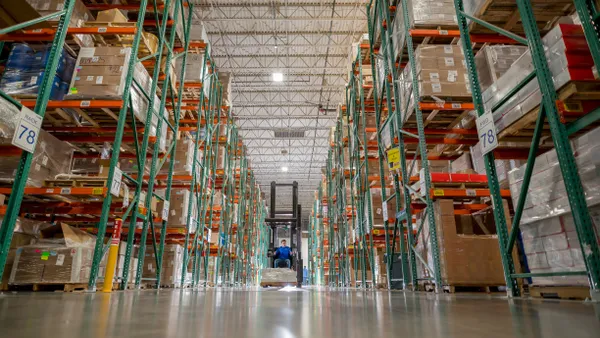Dive Brief:
- The grocery and food sectors are leading in the adoption of cold chain monitoring, followed closely by manufacturing in the plastics and pharmaceutical spaces, according to survey results in the Forrester report "IoT Solutions Transform The Cold Chain."
- Better monitoring of temperatures in refrigerated warehouses could help to cut back on food waste as temperatures that are either too high or too low can result in loss. "It is widely agreed that temperature is a significant environmental attribute concerning product spoilage," reads the 2018 paper "New trends in cold chain monitoring applications" by Ricardo Badia-Melis, a cold chain consultant at Zest Labs, and other researchers.
- "What's behind the value proposition to the warehouse manager is getting the information faster about if there are problems, and then to be able to head that off," Michele Pelino, a principal analyst at Forrester who worked on the cold chain report, told Supply Chain Dive.
Dive Insight:
Traditionally, warehouse managers have had to manually collect information from temperature gauges or by looking at the product. Cold chain monitoring with sensor-based technology, however, allows these managers to focus instead on fixing problem areas, Pelino said. This transitions the warehouse manager from a role of collecting raw data to one of analyzing data.
Investing in cold chain monitoring technology is something a company has to weigh internally, Pelino said. Are the losses experienced by poor temperature control enough to justify the cost?
"You have to think about what is the balance of cost and losing that possible revenue stream, especially when margins are pretty slim in a grocery environment for some of these products" like fruits and vegetables, Pelino said.
And if the investment cost turns out to be worth it, then it's a matter of determining how exactly to monitor the cold chain. There are a variety of methods, according to Badia-Melis' paper.
- RFID and wireless sensor networks (WSN): These technologies "are considered by many to be leaders in their field for cold chain monitoring." RFID sensors are able to capture the location and temperature and communicate this information back to a database with more computational power that can calculate parameters like an estimated remaining shelf life. WSN devices typically have more sensors than RFID and have integrated member, but are also more expensive. RFID and WSN devices are usually limited to one per pallet, but the data collection involved can be relatively substantial.
- Temperature estimation: The temperature is not consistent with a package of food, which means the insight from a single RFID sensor could be limited. But some research has shown an artificial neural network can use the temperature of the area outside of a food container to estimate the temperature inside. The downside, though, is the model requires training that could disrupt a business' logistics.
- Thermal imaging: Thermal imaging could be used to decrease the number of actual sensors (RFID or WSN) used within a storage setting. But this technology can struggle depending on the type of packaging or surface it is trying to measure.
- Computational Fluid Dynamics (CFD): This is a technique for analyzing airflow during the cooling process and can be used to determine the optimal ventilation for crates, pallet distribution and other variables within cold storage.
One complicating factor here is that it's hard to suggest a one-size-fits-all solution for cold chain monitoring. Supply chains vary depending on location and product, and monitoring needs will similarly change depending on the goods being shipped and where they're going. Needs can also depend on various regulatory requirements depending on the sector, Pelino said.
This kind of monitoring can extend beyond the warehouse to get a whole view of the supply chain's climate. Then, companies would also have to consider if they want real-time data or if they simply want to look at data when products arrive at a port or another location, she said.
As grocery delivery and meal kit delivery services take off, monitoring the quality of products will be critical to provide a good customer experience and retain customers, Pelino said.
RFID, WSN and other technologies could be part of ensuring that quality. For now, cold chain monitoring is not widespread within any sector, according to Forrester's survey results. But this could change as the price of technology goes down and early use cases begin to bear (fresher) fruit.
This story was first published in our weekly newsletter, Supply Chain Dive: Operations. Sign up here.














